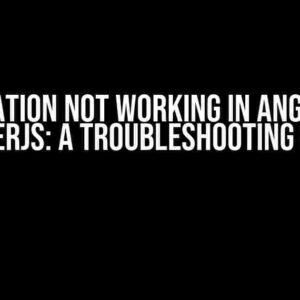Are you tired of dealing with the pesky double-scrolling issue that occurs when flex-wrap kicks in? You’re not alone! Many developers have struggled with this problem, but fear not, dear reader, for we’ve got the solution right here. In this article, we’ll dive into the world of flexbox and explore the reasons behind double scrolling. We’ll also provide you with practical solutions to disable CSS double scrolling once flex-wrap kicks in.
What is Flexbox and Flex-Wrap?
Before we dive into the solution, let’s quickly cover the basics. Flexbox, also known as flexible box, is a layout mode in CSS that helps you create flexible and responsive layouts. It’s particularly useful for creating layouts that require flexible sizing, alignment, and distribution of elements.
One of the key properties in flexbox is flex-wrap, which determines whether flex items should wrap to a new line or not. When flex-wrap is set to wrap, the flex items will wrap to a new line when the container reaches its maximum width. This is where the double-scrolling issue often occurs.
The Double-Scrolling Issue
So, what exactly is the double-scrolling issue? It’s a phenomenon where the browser creates two scrollbars: one for the container and another for the flex items. This happens when the flex items wrap to a new line, causing the container to overflow, and the browser creates a second scrollbar to accommodate the overflow.
This issue can be frustrating, especially when you’re trying to create a seamless user experience. But don’t worry, we’ve got some solutions for you!
Solution 1: Using overflow-hidden on the Container
.container {
display: flex;
flex-wrap: wrap;
overflow: hidden;
}
This solution works because the overflow-hidden property prevents the container from overflowing, which in turn removes the need for a second scrollbar.
Solution 2: Using flex-wrap: wrap-reverse
.container {
display: flex;
flex-wrap: wrap-reverse;
}
By using flex-wrap: wrap-reverse, you’re telling the flex items to wrap in the opposite direction, which can help prevent the overflow issue that causes double scrolling.
Solution 3: Using a Wrapper Element
.wrapper {
overflow: auto;
}
.container {
display: flex;
flex-wrap: wrap;
}
In this example, the wrapper element is given an overflow: auto property, which creates a separate scrolling context for the flex items. The container element is then given a display: flex and flex-wrap: wrap property to create the flexbox layout.
Solution 4: Using a Polyfill
<script src="https://cdn.jsdelivr.net/npm/[email protected]/dist/flexbox-ie10.min.js"></script>
Conclusion
| Solution | Description |
|---|---|
| Using overflow-hidden on the Container | Adds the overflow-hidden property to the container to hide any overflow content. |
| Using flex-wrap: wrap-reverse | Tells the flex items to wrap in the reverse direction, which can help prevent the double-scrolling issue. |
| Using a Wrapper Element | Creates a separate scrolling context for the flex items by using a wrapper element. |
| Using a Polyfill | Provides support for older browsers that don’t support flexbox natively. |
Frequently Asked Questions
-
Q: What is the main cause of double scrolling in flexbox layouts?
A: The main cause of double scrolling is the overflow of flex items, which creates a second scrollbar.
-
Q: Does using overflow-hidden on the container affect the layout?
A: No, using overflow-hidden on the container only affects the scrolling behavior and doesn’t affect the layout.
-
Q: Can I use flex-wrap: wrap-reverse on older browsers?
A: No, the flex-wrap: wrap-reverse property is not supported on older browsers. You’ll need to use a polyfill or a different solution for older browsers.
Here are 5 Questions and Answers about “How to disable CSS double scrolling once flex-wrap kicks in?” in HTML format:
Frequently Asked Question
Get the answers to your most pressing questions about disabling CSS double scrolling once flex-wrap kicks in!
Why does CSS double scrolling occur when using flex-wrap?
CSS double scrolling occurs when using flex-wrap because the browser creates a new scrolling context when the flex container wraps to a new line. This new scrolling context causes the scrollbars to appear again, resulting in double scrolling.
How can I prevent double scrolling when using flex-wrap?
To prevent double scrolling when using flex-wrap, you can add the `overflow: auto` property to the flex container, and set `max-width` or `max-height` to limit the container’s dimensions. This will prevent the browser from creating a new scrolling context.
Can I use CSS grid instead of flexbox to avoid double scrolling?
Yes, you can use CSS grid instead of flexbox to avoid double scrolling. CSS grid does not create a new scrolling context when wrapping to a new line, so you won’t experience double scrolling.
What if I need to use flexbox and still want to disable double scrolling?
If you need to use flexbox and still want to disable double scrolling, you can add `overflow-y: hidden` to the flex container and `overflow-y: auto` to its parent element. This will prevent the browser from creating a new scrolling context.
Are there any other workarounds to disable double scrolling with flex-wrap?
Yes, another workaround is to use JavaScript to detect when the flex container wraps to a new line and then set the `overflow-y` property to `hidden` on the container. However, this approach can be more complicated and may have performance implications.




